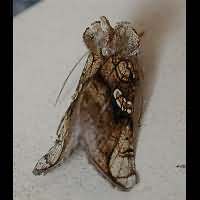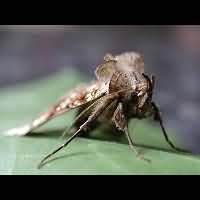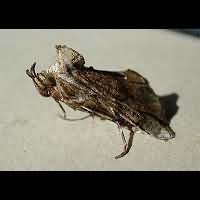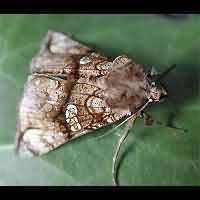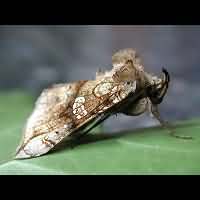Golden Plusia Polychrysia moneta
The Golden Plusia is an unmistakable species: two large tufts of hair grow just in front of the wing. These are fan-shaped and do look like giant ears. There also is a very big silvry white kidneymark on the forewing. The markings are very constant, but the basic colours varies from yellowish brown, through goldbrown to rather darkbrown. The wingspan is some 38 to 44 mm.
The eggs are laid in August mainly. After hatching the larvae often live in a small group. This group spins a little web on the underside of a leaf. They spend the day together in this web and feed in the open by night. The small caterpillars of the Golden Plusia overwinter. In spring they live a solitary life and spend the night uncovered on the underside of a leaf. In April a cocoon is made, also on the underside of a leaf, in which pupation takes place. Fresh cocoons are white, older ones yellow. Late June the first moths appear. Sometimes in southern parts of England a second generation appears in September. The caterpillars of this generation can be found in July and August and grow extremely fast. Young larvae are green with small black spots. Full grown larvae are light green. They have a small white line running on the sides and a fine double white line on the back. The larvae are plump, but reaching some 33 to 38 mm not very long. They are very similar to those of some other Plusia species, such as the Burnished Brass and the Plain Golden Y. Larvae of the Golden Plusia can be found on a small number of garden plants exclusively: Larkspur, Trollius and Monkshood.
The Golden Plusia is on the wing from mid June to mid August, eventhough locally a partial second brood may appear in England in September. It flies by night only and is not really attracted to light or sugar. Best seen when visiting garden flowers. Widespread and fairly common all over Britain, but never appearing in very great numbers. Elsewhere in Europe this species is usually rather scarce as well, but flies in two generations south of Britain.
The Golden Plusia is an unmistakable species: two large tufts of hair grow just in front of the wing. These are fan-shaped and do look like giant ears. There also is a very big silvry white kidneymark on the forewing. The markings are very constant, but the basic colours varies from yellowish brown, through goldbrown to rather darkbrown. The wingspan is some 38 to 44 mm.
The eggs are laid in August mainly. After hatching the larvae often live in a small group. This group spins a little web on the underside of a leaf. They spend the day together in this web and feed in the open by night. The small caterpillars of the Golden Plusia overwinter. In spring they live a solitary life and spend the night uncovered on the underside of a leaf. In April a cocoon is made, also on the underside of a leaf, in which pupation takes place. Fresh cocoons are white, older ones yellow. Late June the first moths appear. Sometimes in southern parts of England a second generation appears in September. The caterpillars of this generation can be found in July and August and grow extremely fast. Young larvae are green with small black spots. Full grown larvae are light green. They have a small white line running on the sides and a fine double white line on the back. The larvae are plump, but reaching some 33 to 38 mm not very long. They are very similar to those of some other Plusia species, such as the Burnished Brass and the Plain Golden Y. Larvae of the Golden Plusia can be found on a small number of garden plants exclusively: Larkspur, Trollius and Monkshood.
The Golden Plusia is on the wing from mid June to mid August, eventhough locally a partial second brood may appear in England in September. It flies by night only and is not really attracted to light or sugar. Best seen when visiting garden flowers. Widespread and fairly common all over Britain, but never appearing in very great numbers. Elsewhere in Europe this species is usually rather scarce as well, but flies in two generations south of Britain.


